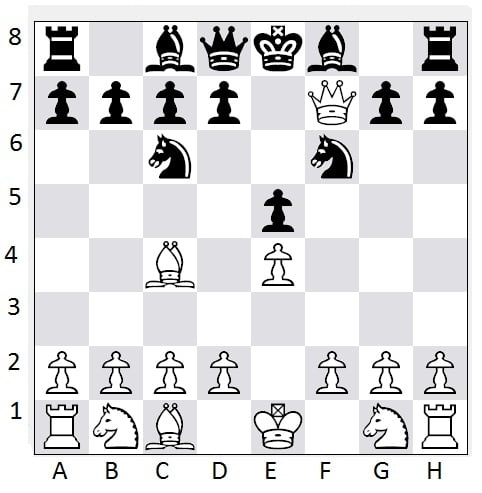

Путешествие в шахматное королевство (in Russian). The moves might be played in a different order or in slight variation, but the basic idea is the same: the queen and bishop combine in a simple mating attack on f7 (or f2 if Black is performing the mate). ^ Averbakh, Yuri Lvovich Beilin, Mikhail Abramovich (1972).^ Fischer, Bobby Margulies, Stuart Mosenfelder, Donn (1972).Chess: 5334 Problems, Combinations, and Games. ^ a b c Hooper, David Whyld, Kenneth (1992).There is another possible three move mate for white, 1. Further, a similar mate can occur in From's Gambit: 1. Qh5# has been attributed to Masefield and Trinka, although the players' names have also been reported as Mayfield, Mansfield, Trinks, or Trent. Qh5 #.Ī possibly apocryphal variant of the fool's mate has been reported by several sources.

This game took three moves!!" One possible sequence leading to the position is 1. The solution in Fischer's book bore the comment "Black foolishly weakened his King's defenses. However the same principle applies with the mate given with the Queen and Bishop.

This mate happens with higher rated players as well, although rare. White, played by Michael, successfully performs Scholar’s Mate. A board position illustrating White's version of the fool's mate-with White to mate-was given as a problem in Bobby Fischer Teaches Chess, and also as an early example in a compendium of problems by László Polgár. This is a game that took place in 1952 between Michael Meyer and Douglas Newcomb. In both cases, the principle is the same: a player advances their f- and g-pawns such that the opponent's queen can mate along the unblocked diagonal. When the roles are reversed, however, White requires an extra third turn or half-move, known in computer chess as a ply. It ends the game after only four moves by. It is possible for White to achieve a very similar checkmate. What Is The Scholars Mate The Scholars Mate is one of the most well-known checkmating patterns among chess players. A player may also suffer an early checkmate if the f- and g-pawns are advanced prematurely and the kingside is not properly defended, as shown in historical miniature games recorded in chess literature.Ī problem with White to mate instead, given by Fischer and Polgár. Black can be mated in a complementary situation, although this requires an additional move. The mate is an illustration of the kingside weakness shared by both players along the f- and g- files during the opening phase of the game. Even among rank beginners, this checkmate rarely occurs in practice. The fool's mate received its name because it can only occur if White commits an extraordinary blunder. It can be achieved only by Black, giving checkmate on the second move with the queen. In chess, the fool's mate, also known as the two-move checkmate, is the checkmate delivered after the fewest possible moves from the game's starting position.


 0 kommentar(er)
0 kommentar(er)
